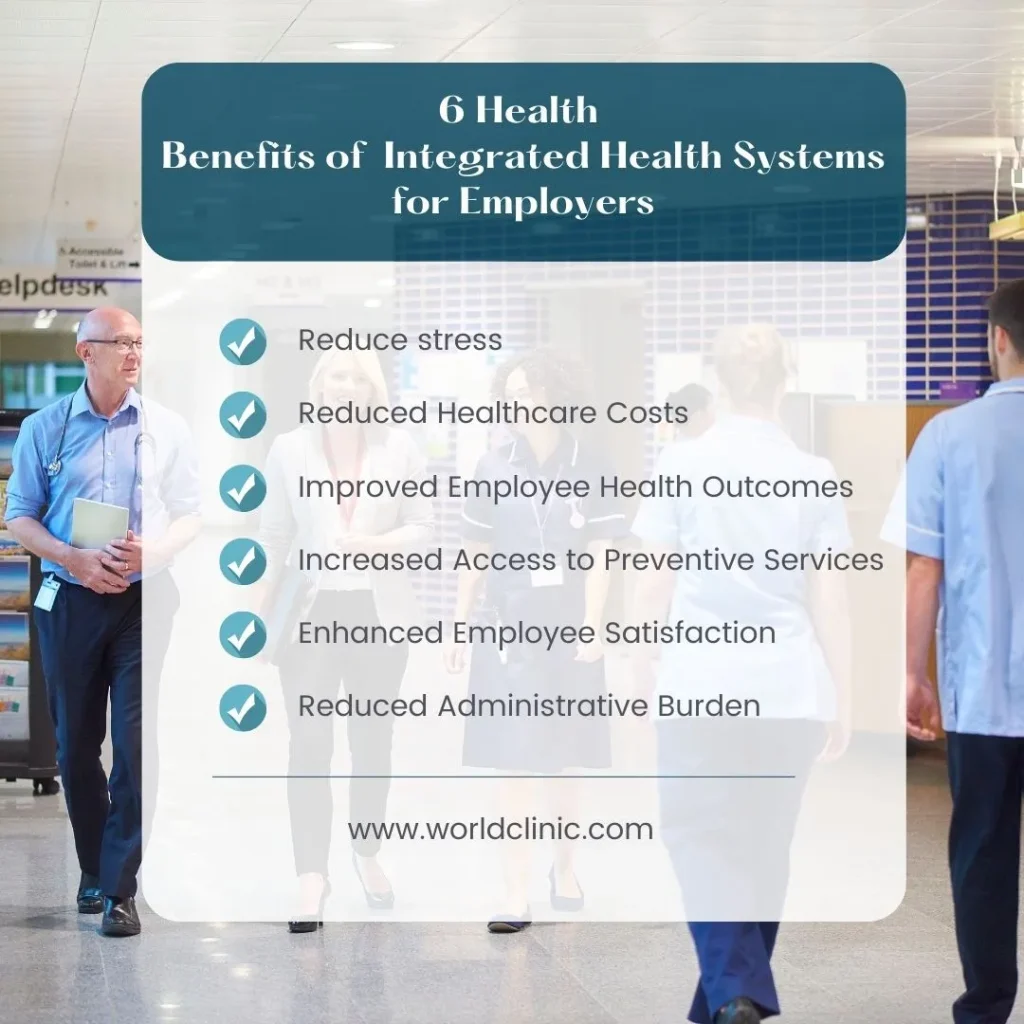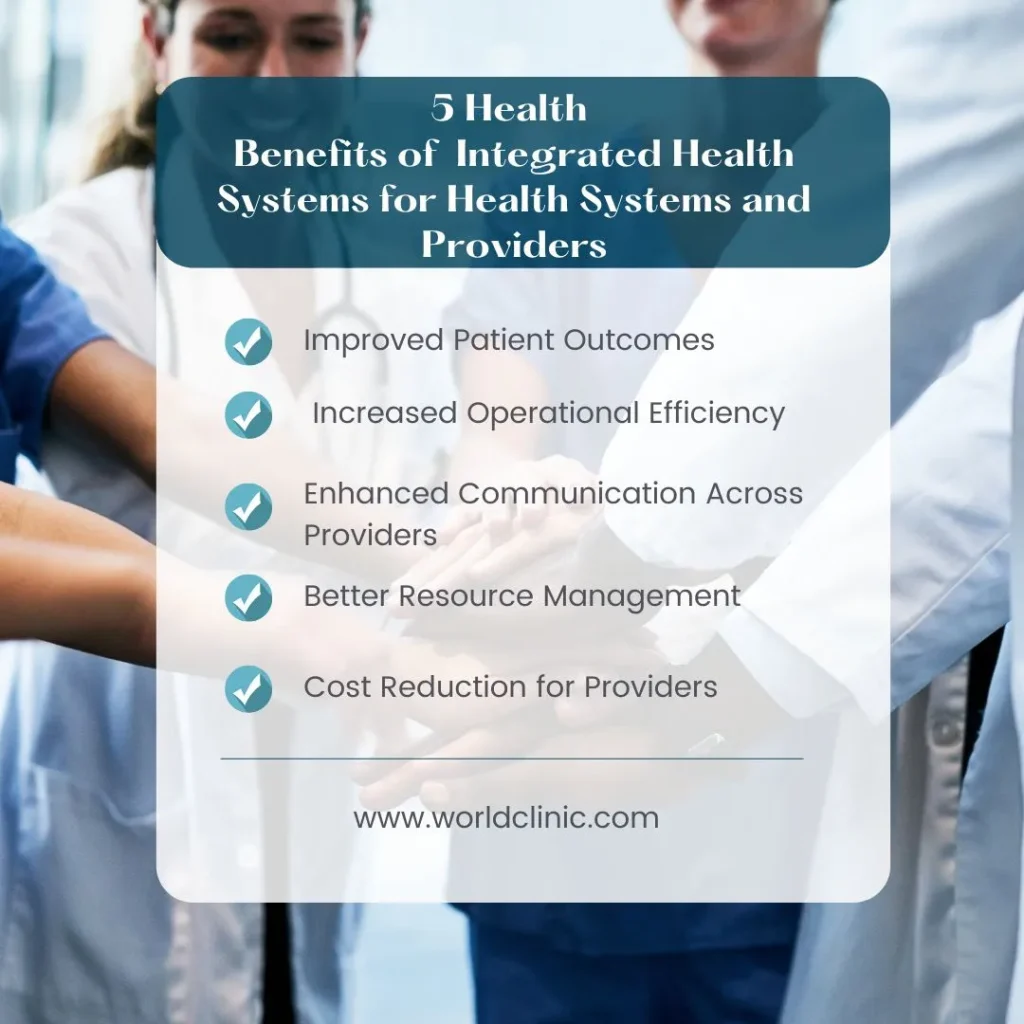Healthcare is evolving day by day. It is now an extremely complex landscape where many different models of care coexist. One of those models is the integrated health system.
While integrated health systems are somewhat new, the concept of treating the body as a whole rather than organ by organ is ancient. In 2023, the market was worth $19.57 billion, and it is expected to more than double by 2030.
The growth of this market and model is not surprising. It has many benefits, including cost reductions, better care coordination, higher quality of care, and more. These benefits serve both healthcare providers and employers who offer employee health benefits to their staff.
If you’re interested in learning a bit more about how an integrated health system works, you’re in the right place. In this blog, we’ll tell you all about the structure of integrated health systems, their benefits for employers and health systems, and much more.
What is an Integrated Health System?
An integrated health system is a healthcare model that combines different health services and providers into a unified framework to be able to treat patients holistically. This helps give patients better quality care with better accessibility.
The top priority within these health systems is to improve patient outcomes and give consistent and coordinated care involving many primary care doctors, mental health practitioners, specialists, etc.
So, why is integrated healthcare important? Well, if you’ve had to deal with long waiting times and lack of organization in a healthcare establishment, you will definitely appreciate this model of not having to wait around to get diagnosed and treated. Plus, this model takes you through fewer unnecessary appointments, lowering the healthcare costs you’ll face.
For an employer, this is especially crucial to understand. Of course, you would want your employees to get quick and high-quality healthcare through the benefits plans you offer them. Aside from showing your workers that you care, it is also just good for business.
On top of that, you would be fulfilling your employer’s duty of care that requires you to provide a safe workplace for your employees. It is a win-win situation.
6 Benefits of Integrated Health Systems for Employers

If you are an employer, investing in an integrated health system can bring you lots of strategic advantages.
When you offer your workers a unified healthcare model that connects different medical services, you stand to reduce your costs and make your workers happier. And remember, happy workers are productive workers.
Let’s dive deeper and talk about the 6 main benefits of integrated health systems you should know about as an employer.
1. Streamlined Care Coordination
Integrated health systems are built to make communication and data sharing smoother across healthcare providers. They have amazing care coordination, which helps patients miss fewer appointments, not be forced to give duplicate tests, and ultimately, get more efficient treatment.
For employers, this means that their workers will have fewer work disruptions and will return to work quickly after receiving timely care.
2. Reduced Healthcare Costs
Another huge advantage of integrated healthcare benefits plans for employers is that it benefits your bottom line. Your workers won’t have costly emergency visits, redundant tests, or procedures.
This cost-saving, proactive, and coordinated care makes sure that health issues are addressed early on and results in lower overall healthcare expenses for employers.
Considering that a basic package for an executive physical costs around $2500, employers would want to save costs wherever possible.
3. Improved Employee Health Outcomes
The next benefit of an integrated health system is that your employees simply get better health outcomes. They receive care on time, pass through preventive screenings, and have ongoing health management support.
Having healthier employees means that they will take fewer sick days, making your workforce more resilient and productive.
4. Increased Access to Preventive Services
With an integrated health system, you have many different types of healthcare providers under one roof. This means that your workers will have more access to a variety of care types, including the advantages of preventive care. These services are delivered through:
- Regular check-ups
- Annual executive physicals
- Wellness programs
- Mental health support
- And much more
Ultimately, preventive medicine will help your workers detect and manage any health issues early on. This reduces long-term risks and improves the employee’s engagement with their own health.
5. Enhanced Employee Satisfaction
With integrated health systems, employees usually have higher satisfaction. Who wouldn’t want to have access to an all-in-one healthcare model that gives them coordinated support?
The benefit for employees here is that satisfied employees stay with your company longer, increasing your retention rates and making your workers more engaged.
6. Reduced Administrative Burden
With traditional health insurance, your HR and benefits teams have a huge administrative burden on their shoulders. With an integrated health system, all healthcare services are consolidated into a single system, reducing the overall burden of administrative tasks.
As an employer, you get to free up valuable resources and let your teams focus on more critical areas of employee support and company growth.
5 Benefits of Integrated Health Systems for Health Systems and Providers

Besides being highly beneficial to employers and patients, integrated health systems are great for healthcare providers and systems. In a nutshell, they create a more efficient and patient-centric approach to care.
The unified patient treatment strategy that is prevalent in membership medicine helps health providers reduce redundancies, manage their resources better, operate more efficiently, and much more.
There are too many benefits here to discuss, so we’ve narrowed them down to the top 5. Let’s see what they are.
1. Improved Patient Outcomes
An integrated health system improves the health results of patients, which is a great achievement for providers. Thanks to continuity of care and a lower risk of medical errors, the system simply achieves better outcomes.
Working in a framework with coordinated services lets doctors give patients a more holistic medicine approach, which brings stronger long-term health.
2. Increased Operational Efficiency
If a provider becomes a part of an integrated health system, their operational efficiency will only go up. They’ll have more control over resource allocation thanks to fewer redundancies and a more streamlined care process.
With an efficient model like this, healthcare providers can focus on delivering quality care, minimize waste, and better manage their costs.
3. Enhanced Communication Across Providers
When we talk about integrated health systems, we’re not only talking about having different health services under one umbrella for quick references. Instead, almost everything else is integrated as well, including sharing patient records and using streamlined channels that allow providers to work cohesively on one patient.
This coordinated communication and data sharing helps reduce delays and gives patients a more seamless healthcare experience.
4. Better Resource Management
Integrated health systems usually come hand in hand with effective resource management. This lets healthcare organizations maximize their staffing, equipment, and facilities.
A structured approach like this makes sure that a provider isn’t underusing or overusing its resources, which leads to a more sustainable healthcare model.
5. Cost Reduction for Providers
Integrated health systems save money for everyone, including patients, employers, and healthcare providers. The costs are reduced thanks to:
- Fewer duplicate tests
- More efficient treatment plans
- Minimal administrative overheads
- No more unnecessary interventions
All the above leads to lower operating costs for the overall healthcare system. These costs can later be allocated toward quality improvements and innovations in patient care.
Core Components of Integrated Health Systems
Integrated health systems usually have many moving parts. To help you understand the depth and width of these systems, let’s talk about the essential components that contribute to the seamless and comprehensive care that integrated health systems have.
1. Primary Care Coordination
Primary care is the foundational component of an integrated health system. Within this model, primary care providers play a central role in managing patients. Essentially, they are the first and main point of contact for patients and they coordinate additional care whenever necessary.
With this approach, continuity of care is under the spotlight, minimizing fragmentation and making sure patients have a consistent healthcare provider who knows all of their medical history.
2. Specialty Care Integration
While a traditional healthcare model might lack specialty care services, integrated health systems have this component built in. They give patients access to areas of healthcare such as cardiology, dermatology, oncology, and more.
Having this network of services makes sure that patients get timely specialized care without any unnecessary delays or fragmentation.
3. Mental Health Services
Having a holistic healthcare approach means treating not only physical symptoms but mental health issues as well. In an integrated system, mental health providers can collaborate with primary and specialty care physicians to heal the whole body.
When you’re looking for a comprehensive healthcare model that fosters total well-being, integrated health systems come in to save the day.
4. Telemedicine and Remote Care
Unlike traditional healthcare models, integrated health systems offer different types of access to care. By using telemedicine and remote care technologies, these systems expand their accessibility.
Telemedicine services, often used by executive healthcare providers, give patients the opportunity to get in touch with providers and doctors remotely, eliminating the need for in-person visits in a time-sensitive situation.
This amazing and convenient component of integrated health systems supports care continuity and makes sure that patients who live in remote or underserved areas can still get high-quality care.
Overall, this benefit of integrated systems fulfills its goals of being more responsive and accessible.
5. Care Coordination and Case Management
Finally, let’s talk about care coordinators and case managers. They play a huge role in overseeing patient journeys throughout the healthcare system to make sure it is working like a well-oiled machine.
These professionals help smooth out communication across different providers, handle the management of secure patient information sharing, and support the patients’ transitions between care levels like going from hospital to home care.
If you’re looking to invest in integrated health systems for yourself, your employees, or your healthcare clinic, WorldClinic can help. We offer premium concierge medical services and executive health plans that are available 24/7 and on demand.
Conclusion
An integrated health system is a modern solution that brings new life to the traditional healthcare model. It benefits everyone involved, including employers, patients, and healthcare providers alike.
With better care coordination, reduced costs, and improved health outcomes, integrated health systems are becoming an increasingly popular choice.
For employers, integrated health systems help keep your employees healthy and sharp, supporting a healthier, more productive workforce. For healthcare providers, participating in an integrated health system allows them to boost their operational efficiency and deliver stronger, patient-centric care.
As the healthcare needs of a modern-day patient evolve, integrated health systems stand as the new big thing. Do patients want more accessible and high-quality care without the hassle? Integrated health systems are the solution.
If your organization is ready to explore the benefits of integrated health, we recommend partnering with WorldClinic. Explore our health systems and employer concierge medicine solutions to learn more about how you can combine the dual needs of accessible healthcare and operational efficiency.
Integrated Health System FAQs
How does an integrated health system differ from traditional healthcare models?
An integrated system combines various healthcare services within a unified network where patients are referred to the right doctors who share patient records. On the other hand, traditional models often have fragmented services that take patients from one doctor to another, one test to another, which results in tons of redundancies and an inefficient process.
What types of services are typically included in an integrated health system?
Integrated health systems usually include services like primary care, specialty care, support for mental health, telemedicine solutions, preventive care, and even case management. Combining all of these under one roof results in comprehensive, accessible care that can address the full spectrum of a patient’s needs.
Are integrated health systems suitable for businesses of all sizes?
Usually, yes. Integrated health systems can be flexible to accommodate businesses of all sizes. For larger companies, these systems can be beneficial in terms of costs and improved satisfaction of employees. For smaller companies, robust health packages can be negotiated or built through partnerships, helping them with the recruitment and retention of top talent.
How can employers get started with adopting an integrated health system?
First, employers need to assess the healthcare needs of their workforce. Consulting with integrated health providers like WorldClinic can help clear up next steps. When you work with an experienced provider, tailoring your health plans to align with your business goals becomes easy.
What challenges might healthcare providers face when transitioning to an integrated health system?
As a healthcare provider, some common challenges you might face when transitioning to an integrated health system include:
1. Restructuring your processes
2. Overcoming the learning curve of new technologies
3. Organizing smooth communication among your teams
4. Training your staff to adapt to the new system
While all of these challenges can take time and effort to solve, the long-term benefits of improved efficiency and patient care usually outweigh them.


